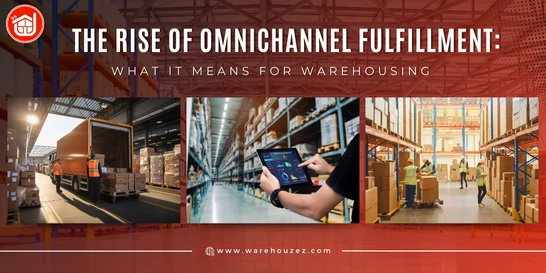An Essential Guide to the Evolution of Warehousing: From Manual to Automated Systems
An Essential Guide to the Evolution of Warehousing: From Manual to Automated Systems
Warehousing is a crucial aspect of supply chain management, playing a pivotal role in storing and transporting goods. Over the years, the world of warehousing has witnessed significant transformations, changing the way goods are stored, organized, and distributed. Gone are the days of labor-intensive processes, as technological advancements are making warehouses more efficient, productive, and adaptable to the ever-changing demands of the global market.
In this particular blog post, we will explore the evolution of warehousing from manual to automated storage systems, discussing the reasons behind this shift and the benefits it brings.
Join us as we delve into the world of warehousing, exploring its past, present, and future!
Introduction to Warehousing and its Importance in Supply Chain Management
At its most basic, warehousing refers to the process of storing goods and products in a designated location or facility before they are distributed to end customers. It involves the systematic arrangement of inventory, coordination of inbound and outbound shipments, and management of the overall storage space. The primary warehousing processes are receiving, putaway, storing, picking, packing, and shipping.
Undeniably, warehousing is a crucial component in supply chain management as it helps ensure the smooth flow of goods from the point of production to final consumption. It provides a centralized location for inventory management, allowing businesses to have better control over storage and distribution. Warehousing also facilitates the consolidation of goods, which reduces transportation costs and improves efficiency. Furthermore, it enables businesses to respond quickly to customer demands by maintaining stock availability. All in all, warehousing plays a pivotal role in ensuring the timely delivery of products, minimizing stockouts, and enhancing customer satisfaction.
Warehouse Management in the Past: Challenges Faced in Manual Warehousing
In the past, warehouse management processes relied heavily on manual labor and paper-based systems. Warehouse workers had to manually track inventory, place and fulfill orders, and manage logistics. This manual approach was time-consuming and prone to errors, leading to challenges such as inventory inaccuracies, inefficient picking and packing processes, and delayed order fulfillment. This led to the need for a warehouse management system (WMS) to streamline operations, improve accuracy, and enhance overall efficiency in warehouse management.
Let's discuss the challenges associated with manual warehouse management:
1. Labor-intensive Processes
One of the major challenges faced in manual warehousing was the heavy reliance on labor for various tasks. This involved physically moving and organizing inventory, which required significant manpower and time. The burden of physical labor often led to inefficiencies and increased costs.
2. Limited Storage Capacity
Traditional warehousing often struggled with limited storage space. This constrained the ability to accommodate a large volume of products, resulting in a constant need for additional storage solutions. This limitation hindered the ability to scale operations and accommodate increasing demand.
3. Inefficiencies in Receiving, Picking, Packing, and Sorting Goods
With a manual warehouse system, there were inefficiencies across day-to-day processes, such as receiving, picking, packing, and sorting goods. Without advanced inventory tracking and warehouse management systems, locating specific products and ensuring accuracy in order fulfillment became a laborious and time-consuming task.
4. Human Errors and Safety Concerns
In traditional warehousing, human errors were more prone to occur. This could include misplacing items, incorrect inventory tracking, or even mistakes in order fulfillment. Moreover, manual handling of heavy or bulky items increased the risk of injuries to workers, leading to safety concerns within the warehouse environment.
All these challenges, combined, led to the need for automated storage systems that could optimize everyday warehouse-related tasks.
The Transition from Traditional Systems to Powerful Warehouse Management Systems (WMS)
In recent times, advancements in technology have revolutionized the way warehouses operate, making them all the more efficient and productive. The introduction of automated systems transformed the warehousing industry, providing increased speed, accuracy, and scalability. Automated systems minimize human error, enhance productivity, and optimize inventory control. The advent of advanced warehouse management system (WMS) further streamlined warehousing processes by integrating real-time data, inventory tracking, order fulfillment, and labor management. WMS not only provides improved visibility and control over warehouse-related operations but also enables better decision-making, cost reduction, and customer satisfaction.
Rise of Warehouse Automation: The Latest Trends in Warehousing
Undoubtedly, technological innovations and milestones have evolved traditional warehouses into smart ones. The introduction of automation technologies has been a blessing to the warehousing industry. These automated systems help with accurate inventory management, efficient receiving and storage, as well as timely order fulfillment.
Let's take a closer look at the latest trends in warehouse management:
1. Automated Storage Systems
The rise of warehouse automation has led to the adoption of automated storage systems, such as AS/RS (Automated Storage and Retrieval Systems) and vertical carousels. These systems use robotics and advanced control systems to efficiently store and retrieve products, reducing the need for manual labor and maximizing storage capacity.
2. Barcode Technology
Barcode technology has become a crucial aspect of smart warehousing. By utilizing barcodes, warehouses can accurately track and manage inventory in real-time. Automated barcode scanners are used to quickly read barcodes on products and update inventory records, leading to improved efficiency and reduced errors.
3. Conveyer System and Sorters
Conveyor systems play a vital role in automating the movement of goods within warehouses. These systems use belts, rollers, or other mechanisms to transport products from one location to another. Additionally, sorters are often integrated into conveyor systems to automatically sort products based on predetermined criteria, such as destination or SKU. This automation streamlines the order fulfillment process and minimizes manual handling.
4. Warehouse Management Systems
Warehouse management systems have evolved to keep up with the advancements in automation. These systems utilize advanced algorithms to optimize warehouse operations, including inventory management, storage, order picking, packing, and shipping.
Benefits of Automated Warehousing
The benefits of warehouse automation are abundant, ranging from cost savings to increased efficiency and productivity.
Here's a breakdown of the benefits of automated warehousing:
1. Increased Efficiency and Productivity
Automation technologies help streamline the entire process, allowing for faster and more efficient handling of goods. With automated storage systems, tasks such as packaging, sorting, and transportation of products can be completed at a much faster pace. This leads to increased productivity as more operations can be carried out within a shorter time frame.
2. Reduction in Errors and Improved Accuracy
Advancements in technology, like warehouse management system certainly minimize the occurrence of human errors. With the use of computerized technology, there is a reduced chance of misplacing or mislabeling products, leading to improved accuracy in inventory management. This not only prevents losses but also saves time that would otherwise be spent trying to rectify errors.
3. Enhanced Safety Measures
Today's smart warehouses prioritize safety by minimizing the need for manual handling of heavy machinery and materials. This reduces the likelihood of accidents or injuries caused by human error. Additionally, automated systems can monitor environmental conditions such as temperature and humidity, ensuring that goods are stored in optimal conditions.
Wrapping Up
To wrap things up, the evolution of warehousing from manual to automated systems has had a tremendous impact on the efficiency and productivity of the industry. Through the use of advanced technology, warehouses are now able to handle larger volumes of goods, reduce errors, and improve overall customer satisfaction. By understanding the benefits and limitations of both manual and automated systems, warehouse operators can make informed decisions about integrating technology to optimize their operations and stay ahead in an increasingly competitive market.



